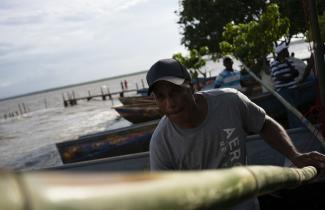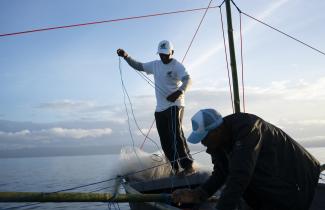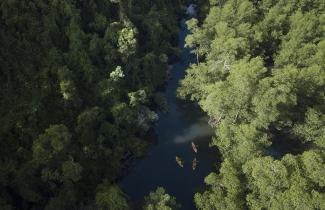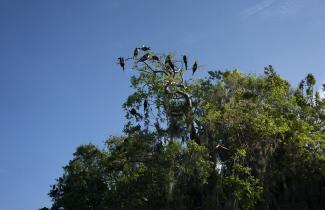The Right Lure
Proving economic opportunity and conservation can coexist
Narrative by Angela Rucker, USAID | Photos and video by Thomas Cristofoletti for USAID
March 2019

'Like a Butterfly'
“We fish with the suripera because it’s a net that doesn’t cause damages,” Yamará says. “Everything the suripera picks up is alive. It doesn’t pick up little fish, only live shrimp.”
Once unfurled, the poles and nets strung together look like a butterfly ready to take flight. When the boat reaches a good fishing spot, Yamará and José lower the fishing nets into the bay in search of shrimp and other fish.



Fish are Disappearing
For years, the shrimp and other fish that had once been plentiful have been disappearing. Overfishing and harmful fishing practices are emptying the bay and threatening the livelihoods of fisherfolk in the community.
A particularly harmful fishing technique nicknamed the “blender” churns up fish en mass and harms the vital coral reefs.



José Alberto tells Yamará stories of the old days when shrimp and fish were plentiful. “There was everything,” Yamará says. “I even hear the older people say that they would take a palm leaf and drag it and they would catch shrimp and fish that way. But you don’t see that anymore with all the damage the bay has suffered.”

To Save the Bay
USAID and other partners, including the U.S. Forest Service, support several initiatives to protect the bay and revive the livelihoods of the more than 3,000 fishers. That includes improved fishing nets and efforts to grow new coral to replace the decimated coral reefs.
Area fishers are slowly accepting this new approach. Yamará is confident the new practices will gain wider acceptance. He and about 50 others have formed the San Lorenzo Bay Cooperative to organize the sale of their catch, to protect the bay and much more.
Ecotourism Rising
They are expanding their activities from fishing to becoming professional tour guides, leading visitors around their breathtaking home – from birdwatching to kayaying to exploring the mangroves and caves that dot the community. These additional activities are increasing their incomes as well.




“If I use any other nets that are harmful, I’m hurting myself because I won’t be able to survive, my kids won’t be able to survive,” he says. “I think about my kids, about the youth that come after me. I do care, that’s why I use the suripera, because it’s safe.”
About This Story
About 60 percent of the Caribbean’s living coral has been lost over the past 30 years, and today three-fourths of the coral reefs are either degraded or threatened. These underwater structures are the homes, and nurseries, for a variety of sea life. Their loss contributes to economic decline for communities that depend on the income that fishing brings.
USAID is working with countries throughout the Caribbean to conserve marine and coastal biodiversity, and to restore livelihoods for the people who call the region home. This project addresses harmful fishing practices with new techniques. USAID also supports coral nurseries so reefs can be restored and fish can repopulate the waterways.
The Agency and its partners are encouraging community-led ecotourism to share the region’s natural wonders with visitors. As many as 3,000 fishers rely on Samaná Bay for their livelihoods. USAID’s assistance is helping rehabilitate an important resource for this community – and beyond.
Norma Paredes, Information Specialist for USAID's Mission in the Dominican Republic, contributed to this story.



